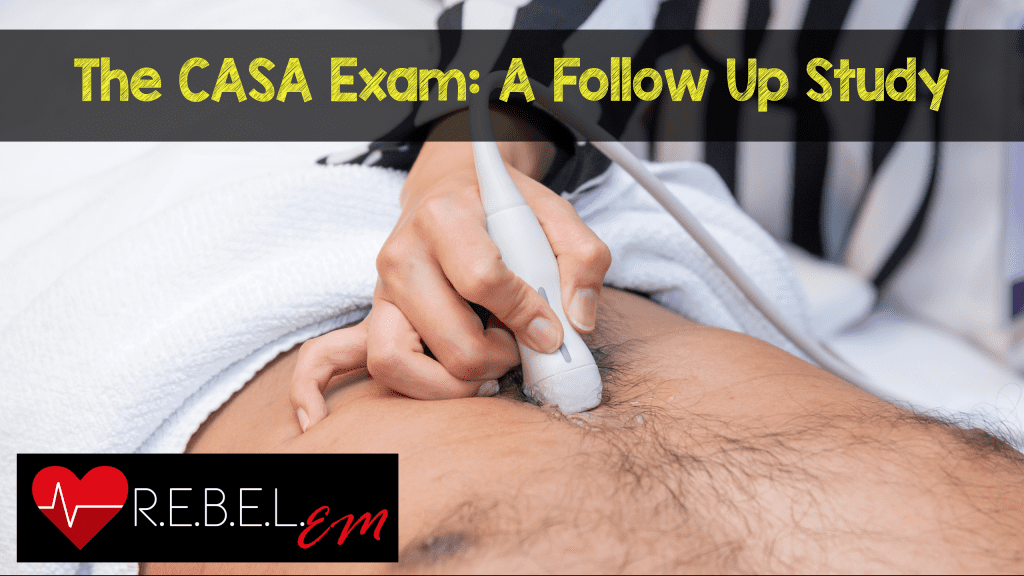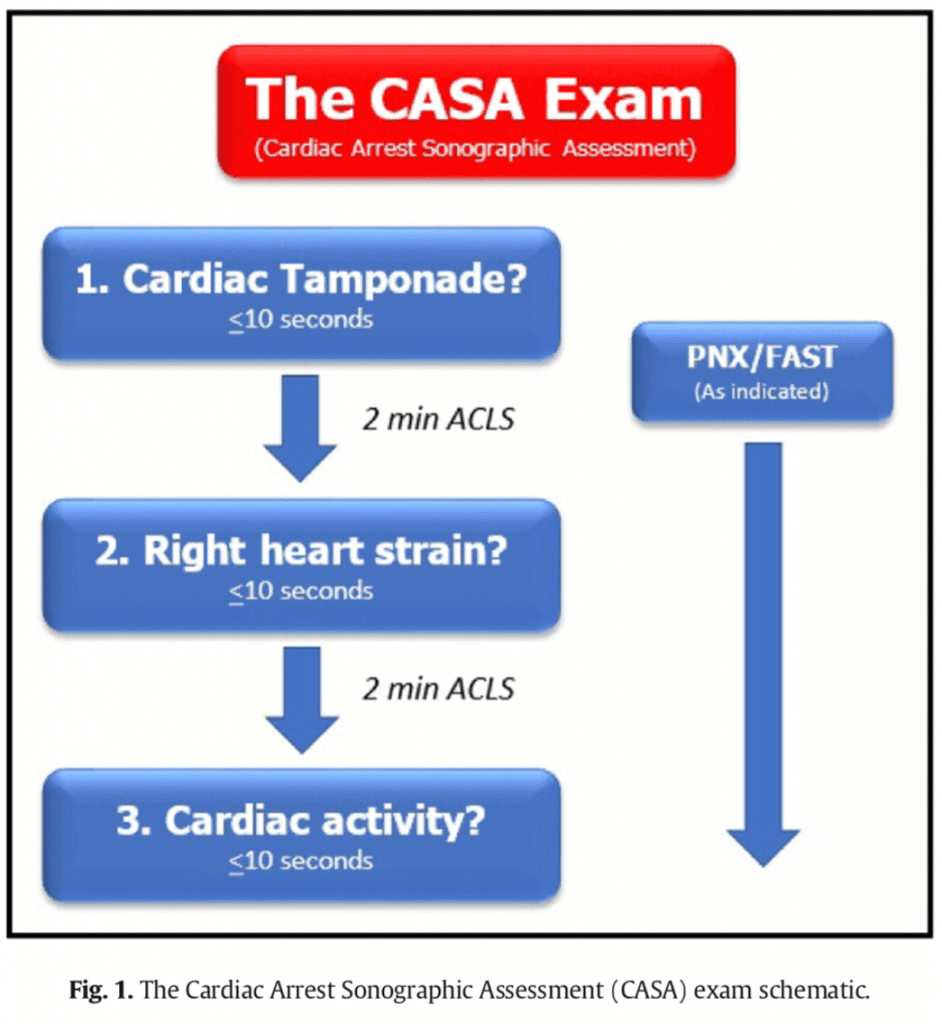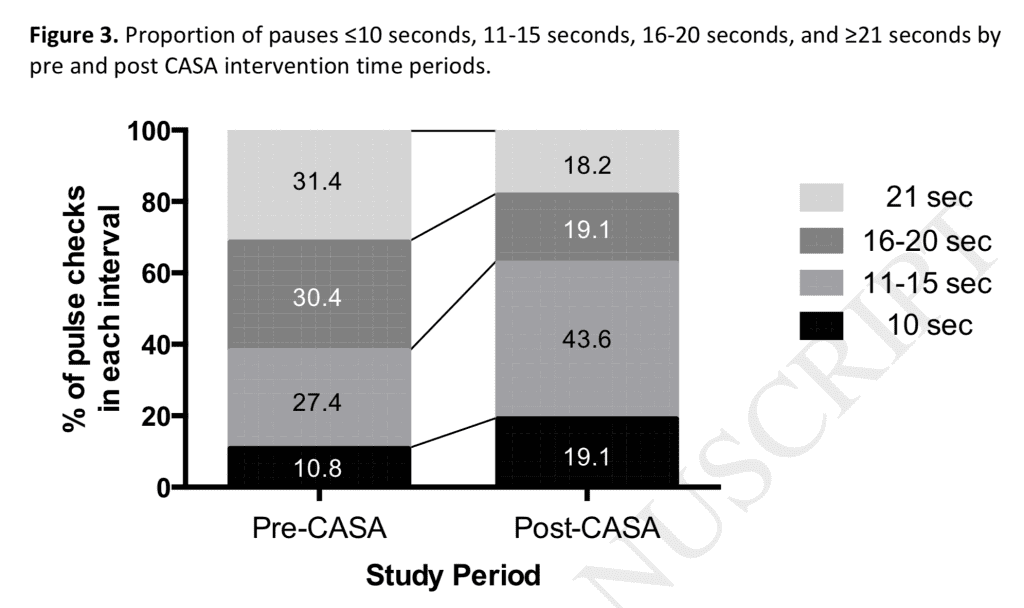
 Background: POCUS has become a powerful tool in the evaluation of critically ill patients in the ED. However, in patients with cardiac arrest, the use of POCUS has been shown to significantly increase the duration of pauses. This is concerning as high quality CPR with minimal interruptions is one of the keys to maximizing ROSC and survival with good neurologic outcomes. Recently, I had the chance to interview the lead author of the Cardiac Arrest Sonographic Assessment (CASA Exam) on REBEL Cast Ep 57 and on that episode we discussed a follow up study, which has finally been published in Resuscitation 2018.
Background: POCUS has become a powerful tool in the evaluation of critically ill patients in the ED. However, in patients with cardiac arrest, the use of POCUS has been shown to significantly increase the duration of pauses. This is concerning as high quality CPR with minimal interruptions is one of the keys to maximizing ROSC and survival with good neurologic outcomes. Recently, I had the chance to interview the lead author of the Cardiac Arrest Sonographic Assessment (CASA Exam) on REBEL Cast Ep 57 and on that episode we discussed a follow up study, which has finally been published in Resuscitation 2018.
What They Did: Quasi-experimental pre- and post-intervention study at a single institution ED to assess whether implementation of the CASA protocol reduces duration of interruptions in CPR during resuscitation of cardiac arrest patients
- CASA Exam: Operator evaluates for cardiac tamponade (1stpause), pulmonary embolism (2ndpause), and cardiac activity (3rdpause).During CPR, the operator assesses for pneumothorax and hypovolemia (IVC & FAST)
- The order of the protocol was chosen to mirror prevalence of the etiology of the cardiac arrest

Outcomes:
- Primary: Difference in CPR pulse check duration between the pre- and post-intervention period
-
Secondary:
- Difference in CPR pause duration without POCUS
- Effect of ED US fellowship training
- Effect of ED procedures (central venous access, intubation, tube thoracostomy, pericardiocentesis, and arterial line)
- Effect of placing the US on chest prior to stopping CPR
Inclusion:
- All adult, non-trauma patients presenting with cardiac arrest or experiencing cardiac arrest in the ED were eligible
Exclusion:
- Traumatic arrest
- Sustained ROSC prior to ED arrival
- No CPR pauses occurred
- Resuscitation not video recorded
- Cardiac arrest run by Physicians’ Assistants (Excluded because they did not participated in CASA didactics)
Results:
- 267 sequential cardiac arrests had data collected
- 38 pre-intervention and 45 post-intervention resuscitations were videoed and included in the analysis
- Median of 3 pulse checks and 2 POCUS exams performed in both groups
- CPR Pulse Checks Involving POCUS:
- Pre-Intervention: 19.8sec
- Post-Intervention: 15.8sec
- CPR pulse checks involving POCUS exams were 4.0sec (95% CI 1.7 – 6.3) shorter in the post-intervention group than in the pre-intervention group
- CPR Pulse Checks Not Involving POCUS:
- Pre-Intervention: 15.4sec
- Post-Intervention: 12.8sec
- P= 0.18
- CPR pulse checks were 3.1sec (95% CI 0.7 – 5.6) shorter when the US probe was placed on the chest before stopping CPR compared to placement after stopping CPR
- CPR pulse checks were 3.1sec (95% CI 0.6 – 5.6) shorter when an ED ultrasound fellowship trained faculty was present compared to non-ultrasound fellowship faculty
- Proportion of pulse checks with ultrasound use increased form 65% pre-intervention to 80% post-intervention
- ROSC
- Pre-Intervention: 34%
- Post-Intervention: 43%
- P = 0.2
- Survival to Hospitalization:
- Pre-Intervention: 29%
- Post-Intervention: 36%
- P = 0.3
- Survival to Discharge with CPC Score of 1 – 2:
- Pre-Intervention: 6.3%
- Post-Intervention: 5.2%
- P = ?? (Not listed in the manuscript)
Strengths:
- Cardiac arrest resuscitations were filmed and analyzed with respect to pause check duration and use of POCUS
- Codes recorded 24hours a day, 7 days a week
- Patients in both time periods were similar demographically and with respect to comorbidities
Limitations:
- This is a pre- and Post-intervention study not a randomized clinical trial, which could result in residual confounding
- Study was unblinded, therefore it is not possible to know what proportion of the findings were related to Hawthorne effect
- Unable to correlate POCUS video clips to CPR pulse checks (i.e. there was no way to ensure residents were performing the protocol in the order it was intended to be done in)
Discussion:
- Breakdown of the proportion of CPR pauses pre- and post-implementation of the CASA exam

- Important to realize that decrease in pause duration could be due to Hawthorne Effect (participants performed better because they were aware that they were being evaluated and not because of the intervention itself)
Author Conclusion:“In this pre and post-intervention study, the implementation of a structured algorithm for ultrasound use during cardiac arrest significantly reduced the duration of CPR interruptions when ultrasound was performed.”
Clinical Take Home Point: Having a scripted protocol for POCUS in cardiac arrest, and placing the probe on the chest during compressions are associated with shorter duration of CPR pulse checks, but even with the CASA exam, CPR pulse checks are still longer than without the use of POCUS. Having a dedicated counter can ensure that pauses with POCUS do not last longer than 10 seconds.
References:
- Clattenburg EJ et al. Implementation of the Cardiac arrest Sonographic Assessment (CASA) Protocol for Patients with Cardiac Arrest is Associated with Shorter CPR Pulse Checks. Resuscitation 2018. PMID: 30071262
For More Thoughts on This Topic Checkout:
- REBEL EM: REBEL Cast Ep57 – Cardiac arrest Sonographic Assessment (CASA) with Lead Author Kevin Gardner, MD
Post Peer Reviewed By: Anand Swaminathan, MD (Twitter: @EMSwami)
The post The CASA Exam: A Follow Up Study appeared first on REBEL EM - Emergency Medicine Blog.
